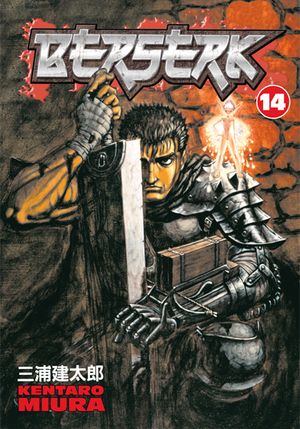
The anime left the Berserk series off in a terrible place as far as telling a complete story. It's one of the reasons why I picked up the manga from Dark Horse.
Here we get to see a little more of how and why things worked out the way they do.
For example, the sword Guts uses? It's a dragon slayer sword made by his smith friend Gordo in a time long ago and far away. It's so big because it's not meant to be used by a normal person. It's a dragon slayer because humans can't fight dragons because they're well, human. The fact that Guts can use it? Well, that's something else.
In addition, Gordo the smith also knows a thing or two about firearms and mechanical limbs. And with the right magnet in place, Guts can use both hands on the sword. The firearm packed into the machine arm proves to be Guts salvation time and time again in the manga in latter volumes. One might almost argue that these creatures Guts fights are vulnerable to the damage that it inflicts.
But outside of some background information on Guts, what can we use in this volume?
One, no one escapes from the inquisition! In Crown of Stars by Kate Elliot and dozens of other fiction series, the chruch is not an entity to take lightly. Here, they're following Guts trail and have their own series of prophecies. Ironically enough, this group, Holy Iron Chain Knights, are for the most part, made up of nobles who donate heavily to the chruch to insure that their children stay out of the way of inheritance issues and serve faithfully. The naming conventions are good and the idea is often used that the second or third sons and daughters must serve the church.
Two, life is cheap in a points of light setting. It's important to note not only for the every day horrors that bandits commit against the innocent, such as selling girls into slavery, but what can happen to the common children. Here, the enemy is an 'elf' based demon who turns children into elf like entities that are flesh eaters and use a horrifying swarm attack to strip the flesh from anything they attack. The other part of horror here is that when slain, these monstrous elf children revert to their human form.
Three, the enemy comes in many shapes and sizes. For example, Guts has to not only fight the demonic elf children, but when souls of those slain in ritual sacrifice around a tree are awoke by the brand on Guts neck, he's got to fight a undead tree possessed of a lust for his blood and warmth.
Four, revenge is always a standard emotion for getting a player involved in a long term quest. Even in old classics like the Princess Bride, if a man is wronged, he will seek to right it. In Guts case, being damned, having all his comrades murdered, and his woman violated, well, these are powerful reasons to want revenge. It's best not to overdo it though. In this case, that's achieved by having these reasons by the foundation that launches Guts on his mission, not necessarily something that's repeated infinitely each issue. After too much loss, the players may get to the point where they expect it and no longer care.
Five, always give the players the option of being heroic but don't force them to do so. In 4e, the alignment system has been pulled back a lot. It still has quite a bit of material there, but in a grim and gritty campaign, such as Berserk or the Black Company might be, the characters are most likely going to be Unaligned in 4e. This means that if you want them to do good things for the sake of doing good things, you'll probably be disappointed.
On the other hand, if you align the characters end goals with the things that others consider to be good, well, things work out well for everyone.





No comments:
Post a Comment